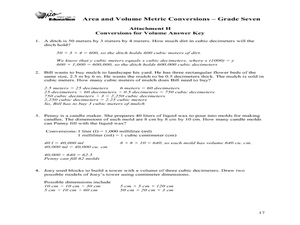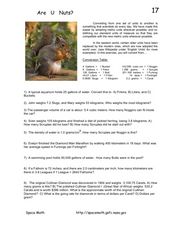Curated OER
Area and Volume Metric Conversions - Grade Seven
Students investigate unit conversion. In this unit conversion lesson, students will build models of square and cubic centimeters using grid paper and generate formula tables for converting units of area and volume. The tables will be...
Illustrative Mathematics
Computing Volume Progression 3
Learners are given a volume of a rectangular tank and are asked to find the water height. Because the total volume of the tank is given in liters, your geometers will need to use a unit ratio to convert to centimeters cubed. The exercise...
EngageNY
Percent
Extend percent understandings to include percents less than one and greater than 100. A great lesson has pupils build upon their knowledge of percents from sixth grade. They convert between fractions, decimals, and percents that are less...
Curated OER
Are U Nuts?
In this conversion worksheet, students solve 9 problems where they convert from one unit of measurement to another using a given table with conversion factors.
Illustrative Mathematics
Christo’s Building
Hook your charges on how to solve a real-world art problem with mathematics by showing works of Christo. You can find eye-catching images on the Christo and Jeanne Claude webpage. Here, math learners help Jean Claude and Christo prepare...
Curated OER
Working with Rates
In this working with rates learning exercise, students solve 9 problems where they find the rates, they solve 5 problems where they find the rates for compound units and they solve 5 problems where they find the rates using scientific...
Illustrative Mathematics
How Many Cells Are in the Human Body?
Investigating the large numbers of science is the task in a simple but deep activity. Given a one-sentence problem set-up and some basic assumptions, the class sets off on an open-ended investigation that really gives some context to all...
Curated OER
Spaced Out
The students are able to use a formula to calculate the volume of cuboids by measuring the length of each of the three dimensions. They also investigate the relationship between milliliters and cubic centimeters.
Curated OER
Twice the Rice, or More?
Students review the metric and customary systems of measurement. In groups, they experiment with rice to discover the difference between the two systems. They record their observations on a worksheet and examine how capacity differs. To...
Teach Engineering
Boxed In and Wrapped Up
If cubes have the smallest surface area, why aren't there more cube-shaped packages? Scholars take a box in the shape of a rectangular prism, cut it up, and make new boxes in the shape of cubes with the same volume. They then brainstorm...
Pennsylvania Department of Education
Determine Volume of Solids Using Water Displacement
Students explore math functions by completing math equation worksheets. In this inequality instructional activity, students define a list of math terms and discuss the difference between an equation and inequality. Students utilize a...
Curated OER
Magnetopause and Solar Storms
In this magnetopause worksheet, students use a given equation to find the distance from the Earth where the solar wind pressure and the Earth's magnetic field pressure are equal. Students are given 5 different solar storms and use the...













